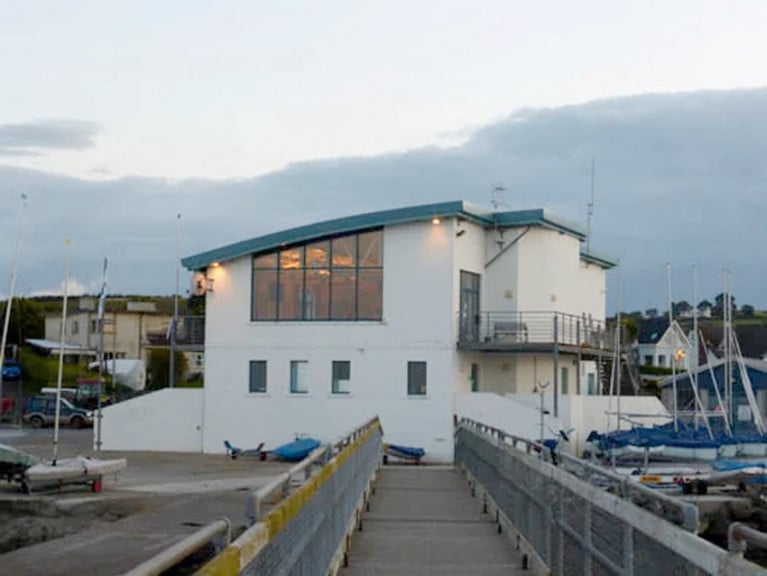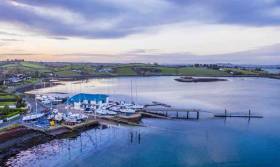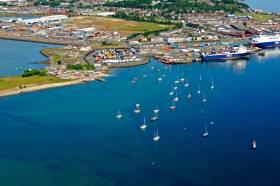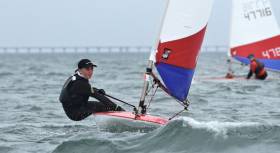Displaying items by tag: Strangford Lough Yacht Club
RYANI Puts Spotlight on Strangford Lough YC’s Training Captain Jack Kennedy
Jack Kennedy from Strangford Lough Yacht Club doesn’t come from a sailing family and is a first-generation sailor. More than 15 years ago he started out on his sailing journey with the club, attending Sunday Sailing, doing his RYA Youth Sailing levels and becoming an instructor.
He understands what it’s like for those who are joining the sport for the first time and has made it his goal to tailor training to their needs. In this special interview with RYA Northern Ireland, Jack reflects on a busy year for the club 2022 and his role as training captain.
Can you tell a bit about your role?
In January 2022, I became training captain at Strangford Lough Yacht Club (SLYC), essentially becoming responsible for organising and overseeing all sailing, powerboat and shore-based training within the Club.
Prior to this, I had been the club’s chief sailing instructor, a powerboat instructor and had been involved in delivering training for over 10 years. So, I already had quite a lot of involvement and experience with training at SLYC and knew what worked and what didn’t work.
The club has run a lot of training courses this year. Could you explain how you planned the course schedule?
Given that it was my first year as training captain and we were coming out of a two-year period of lockdowns and inactivity due to COVID-19, I was keen to deliver a packed training programme. I knew there would be demand for our RYA Youth Summer Sailing courses, as well as the RYA Powerboat Level 2 courses, as these historically have always been popular.
However, we wanted to particularly build on the adult dinghy sailing space, and scheduled four RYA Adult Learn to Sail (Level 1) courses, throughout May to August.
I also wanted to run more RYA Safety Boat courses as these had generally been difficult to find elsewhere in Northern Ireland. The course teaches skills that are so important for volunteers, instructors and parents who want to help out with junior sailing, provide rescue at large sailing events, or become a senior instructor. In my opinion, it was only right we delivered this training.
Lastly, and most recently, the race coaching. Historically SLYC has been fantastic at introducing people to sailing and teaching them the basics. However, we found that after we had done this, the sailors would be hungry for more “race coaching”-style training, and as we didn’t provide this, would leave us for other clubs.
Therefore, we have worked hard to develop our racing fleet, with Tuesday night dinghy racing during the summer season, run by RYA race coaches and experienced instructors. We also introduced winter race coaching for a select group of sailors, who want to go to events and compete on our behalf, and even one day be invited onto the RYA squads.
Have the adult sailing courses been successful?
The adult sailing courses have been an outstanding success, not only from a training perspective, but for the club more generally. We had over 40 adults come through our RYA Adult Level 1 courses this year alone, with many going onto do their Level 2, and in some cases Level 3 courses, in one Summer.
But the real success of our adult sailing courses has been being introducing so many new people to the amazing sport of sailing. Many of the students that attended our courses have ended up joining the club as either single or family members, and are now hiring dinghies and going cruising themselves, or even racing on larger keelboats. Some of our adult sailors have even gone onto purchase their own keelboats and have been winning regattas in the Lough!
Ultimately these courses have provided a platform for us to introduce new people to a sport that historically had a lot of barriers of entry and was difficult to get into if you hadn’t come from a sailing family.
 Children learning to sail in a Laser Bahia on Whiterock Bay in Northern Ireland
Children learning to sail in a Laser Bahia on Whiterock Bay in Northern Ireland
The training was promoted early in the year. Did this have a positive impact and were there any other factors that helped?
Our 2022 Summer training programme went live for bookings on New Year’s Eve! By the end of January, we had already had 133 students booked onto sailing and powerboat courses for the summer.
This level of demand for courses was, at times, scary. I thought I had maybe bitten off more than I could chew. However I was determined to continue with my plan to deliver a packed programme, and introduce as many people as I could to sailing and boating generally, as obviously a lot of people were interested!
I suppose I should say at this point that, if it wasn’t for an amazing team of instructors I would be lost. We have a team of roughly 20 sailing instructors and five powerboat instructors at SLYC. All of whom work tirelessly throughout the year to enable the club to run these courses.
The thing that makes them invaluable is that they are not simply doing it for the pay check, they are doing it because they are passionate for the club, and for the sport generally, and want to see it grow and be successful.
What are the benefits for those who take part in courses?
For the kids who have done sailing courses with us, we run our very popular Sunday Sailing School, which is essentially an opportunity for kids to get our sailing on Sunday morning and practice the skills they have learnt on the courses. This year our Sunday Sailing School became part of the RYA Onboard programme, which allowed us to run a more structured programme, which further aided the development on the kids’ sailing.
For kids that are at a certain level, we have our Tuesday night dinghy racing nights during the summer months and our winter race coaching.
For adults that have been on our courses, we decided to run adult “cruise in company” afternoons, every Sunday throughout October and November. This gave adults the opportunity to go out in the Bahias and cruise together, to build their confidence on the water.
We also held an adult dinghy sailor get-together, which was basically an afternoon open to every adult that had done a sailing course with us to come down for the afternoon, to go sailing and then come back to the club for a BBQ and drinks. It was a great way to meet others in the club with the same interest, and to meet potential crew! The day was a great success.
Looking ahead to 2023, what are your plans?
I would like to replicate what I did this year, however this depends on availability of instructors, as well as other factors such as club facilities. I don’t think I would like to do anything differently next year as I think we are constantly adapting and improving our plan to ensure we continue to deliver the highest quality of training possible.
I am incredibly proud of what the club has achieved over the years, in particular within the last year. I am looking forward to growing on this success in the following years.
Strangford Lough Yacht Club Frostie Series Class One Tie Break in Favour of J109 'Going to Red'
The long-running popular Strangford Lough Yacht Club Frostie Series ended last weekend with the 42-boat fleet having enjoyed a complete ten-race programme in varying conditions over five weekends. Competitors came from clubs around the Lough and from Belfast Lough.
The four-entry IRC 1 ended in a tiebreaker between Peter Holden’s J109 Going to Red from the host club and Mike Spence’s A35 Le Basculer from Killyleagh, broken in favour of Going to Red. The Belfast Lough Sigma 33 Squawk (Paul and Emma Prentice) dominated the nine-entry IRC 2 division with Robert and Alan McDowell’s Impala Whistlin Dixie from East Down YC runner-up.
 Emma Prentice (Squawk), winner of IRC 2 in the Strangford Lough Yacht Club Frostie Series
Emma Prentice (Squawk), winner of IRC 2 in the Strangford Lough Yacht Club Frostie Series
NHC saw the consistent Magdalene with Mike Stephens on the helm win four of the ten races in the Nicholson 43 from East Down, with another EDYC competitor, James Regan, second in the Jeanneau 421 Lizante. The Ramsey/Findlay duo in the Albin Express Self-Expression won NHCRS decisively.
 Mike Stephens (Magdaleyne), winner of NHC in the Strangford Lough Yacht Club Frostie Series
Mike Stephens (Magdaleyne), winner of NHC in the Strangford Lough Yacht Club Frostie Series
It was another visitor from Belfast Lough, the RS Elite The Love Bug from Royal North of Ireland YC on Belfast Lough with Mike Browne, Jane Buchanan and Connor Simms on board who topped the six-boat fleet. Love Bug is this year’s RS Elite Champion.
That class had really close racing for the top three slots, with Love Bug finally taking first from Storm (Polly, Gunning and Kelso) from Royal Ulster and Ballyholme and Tom Purdon from the home club in TNT.
The other one-design fleet, the Sonatas, had seven out and the winner, El Gato had the class won before the last race, which they didn’t start.
Strangford Lough Sailor is BBC Cameraman in Ukraine
The daily news from Ukraine is upsetting and harrowing but we can’t truly know what it must be like to work there.
Strangford Lough Yacht Club member David McIlveen who sails the Hydro 28 Rampart, is an award-winning camera operator working with the BBC’s Clive Myrie as part of the backroom team of BBC satellite engineers, camera crew and safety advisers, who are putting their lives at risk to bring viewers the latest news from a Kyiv.
The i news reports Belfast based David McIlveen’s comments; “We were working on the satellite dish on the roof this morning when incoming artillery fire shook the hotel. We had to scarper down here to the bunker. I was FaceTiming my family to say there we’re all safe and there’s nothing to worry about when the explosions happened.”
David has been in Kyiv for a month, working in the streets and then returning to the makeshift underground studio. He says the team are exhausted.
i news reports that McIlveen won the Royal Television Society Journalism Camera Operator of the Year award for his work filming Clive Myrie’s coronavirus reports from the Royal London Hospital’s wards during the Covid pandemic.
Technical and ethical challenges arise from broadcasting from the bunker as “there are people down there with their families who are very frightened and they need their privacy,” McIlveen said.
Strangford Lough Yacht Club Big Boat Frostie Series Begins This Weekend at Whiterock
At Ballyholme Yacht Club, they call it the Icebreaker- it's for dinghies - and at Strangford Lough Yacht Club, they call it the Frostie Series (it's for big boats). The club lies on the eastern shore of Strangford Lough in Whiterock Bay in Northern Ireland and is looking forward to running the 2021 Frostie Series. Racing begins this coming Saturday (18th September) and ends on 16th October.
The long-running Frostie Series is one of the most popular events of the year, and it is hoped to have a big turnout to mark the end of another brilliant season sailing at Whiterock. There will be racing for IRC 1 (0.950 & over), IRC 2 (0.949 & under,) NHC 1 NHC 2, NHC 1 Restricted Sail, NHC 2 Restricted Sai, Sonatas and RS Elites.
The late entry fee has now kicked in, and registration closes at the end of this week. But with 35 boats entered already and 40 expected, there is still time to join this big fleet for some exciting racing to end the season.
For more information on the event here To enter follow this link here
RYANI Recognises Strangford Lough Yacht Club for Volunteers’ Tireless Efforts Ensuring Safe Return to Water
The second club to be celebrated in RYANI’s Recognition 2020 initiative is Strangford Lough Yacht Club, whose volunteers jumped into action to ensure the club was safe and ‘Covid-ready’ for when everyone could get back on the water.
The club was originally due to open its season at the beginning of May, but with coronavirus restrictions in place across Northern Ireland this wasn’t possible.
Instead, the club’s most dedicated volunteers set about getting safety measures in place for whenever they could open.
Some of the first measures SLYC put into place were hand sanitising stations throughout the club and its grounds. In the early stages a slipway booking system was implemented so the club could control how many individuals were in the club grounds at any one time.
Communication with members was key and there was frequent guidance issued by the club.
A craning team spent a lot of time overseeing the craning in of over 30 boats, which meant that by late May and early June many members and their families were able to safely enjoy cruising on Strangford Lough.
In July, restrictions were eased further and sailing training was permitted — a very important part of the club.
Committee members and instructors worked hard to ensure the club was in a position to safely deliver sailing courses, giving younger people (both members and non-members) the opportunity to take part in water activities in a safe environment while developing their sailing skills.
Club racing also commenced in July, with representatives from all classes getting on the water — providing a much needed sense of normality in very uncertain times.
September saw the return of SLYC’s most popular sailing series, the Frostie. Sailors from all across Strangford Lough eagerly travelled to Whiterock to take part in this annual series.
‘Despite the uncertainty that we all found ourselves in, the determination of many individuals was phenomenal and humbling’
With over 40 boats entered, it was one of the largest entries the club had ever seen and with strict safety procedures in place, it was also one of the most successful.
As the Frostie series came to an end, Covid restrictions came back into play. The craning team were once again working round-the-clock and in difficult weather conditions, ensuring that every boat was successfully recovered.
SLYC senior instructor Jack Kennedy said: “As soon as we were aware that Covid was going to affect things at the club, we took action straight away to get measures in place.”
He added: “Looking back at this year, despite constantly changing restrictions, SLYC delivered a very popular sailing event, training, club racing and cruising to its members and visitors. This was as a result of a fantastic team effort from both the Commodore’s Committee and the general membership of the Club.
“Despite the uncertainty that we all found ourselves in, the determination of many individuals was phenomenal and humbling.
“One of the most fantastic things about this sporting activity is the volunteers it has. So many individuals give both their time and expertise and this year it was needed even more.
“At SLYC, we hope that 2021 brings more normality and that we are able to be fully functional again, hosting sailing events, social events, club racing and training.”
RYANI chief operating officer Richard Honeyford said: “Volunteers at SLYC worked extremely hard to ensure that all measures were taken to ensure the club was safe for members to return to the club and the water.
“While it has been a particularly difficult time for everyone in our sailing and boating community, it is both heartwarming and inspiring to see the dedication and innovative ways our volunteers work.
“I commend SLYC for their efforts and wish them luck for the year ahead.”
Last week Foyle Sailability was the first club to be recognised as part of the RYANI’s Recognition 2020 initiative in lieu of its usual Annual Awards.
Strangford Lough Yacht Club Members Celebrate 85 Years of Sailing
In celebration of 85 years of sailing, 190 Strangford Lough Yacht Club members enjoyed a memorable gala ball in the Clandeboye Lodge Hotel in Bangor. Commodore Rosie Baird said “It was great to see so many members and their guests at our annual prize-giving dinner, where we also celebrated the club's 85th anniversary. It was a fantastic event and a really memorable occasion. SLYC has come a long way from its fairly humble beginnings when the first clubhouse was a small wooden hut on the shore of Whiterock bay.
Although it was not until the 1930s that a yacht club building was constructed at Whiterock, racing had been active in this part of the lough long before this. A key development in the 1920s was the establishment of the River Class in Strangford Lough. Originally raced at Bangor, the first River came to Strangford Lough in 1921.
A significant impetus in the early 1930s came from the formation of the Snipe Class, a 15’ 6” Crosby design dinghy. The first annual meeting of the Snipe Sailing Club at Whiterock was in 1934, by which time there were 44 members and 16 Snipes completed or under construction. In 1934, it was agreed that the club trustees could take a lease on a plot at Whiterock to build a clubhouse. This opened in May 1935, only to be destroyed by fire shortly afterwards.
In 1936, the Snipe Sailing Club and the River class came together as Strangford Lough Yacht Club. The original clubhouse was replaced by a more substantial building which opened in June 1937. Another boat racing at Whiterock in the 1930s was the Lough Erne No 2 class. After WW2, SLYC expanded rapidly, with more new classes, including the Clippers, Glens and Flying Fifteens. By 1953, the Snipe class had disappeared but that year the Flying 15 Class started and by 1958 there were 18 boats in the fleet.
By this time, club membership had risen to 583. In 1956, Cadet dinghies for juniors arrived at the club, and in 1958 Enterprises made an appearance. This was followed in Scorpions, 505s and Mirrors. Some members spent weekends and holidays in their caravans at the Caravan field in Whiterock and the Army Sailing Association was based at the club from the early 1970s for approximately 30 years with active dinghy training and sailing.
The 1937 clubhouse was replaced by the current building in 2000 and further funding in the mid-2000s enabled more development, with additional rescue boats, club dinghies, training facilities, infrastructure improvements and a dinghy pontoon.
SLYC remains one of the premier yacht clubs in Northern Ireland and it is unique in having two Alfred Mylne designed classic racing yacht fleets – all 12 Rivers ever built still race there and the Glen class remains strong. There are also active racing classes of Sonatas, Flying Fifteens and RS Elites, as well as a large fleet of cruisers. The Club has always placed major emphasis on training and development of novice sailors and offers sailing courses throughout the sailing season as well as competitive dinghy racing for Toppers, Lasers and other dinghy classes.
Happy 85th Birthday as Strangford Lough Yacht Club is RYA Club of the Year Award Finalist
Strangford Lough Yacht Club that celebrates its 85th anniversary this weekend is celebrating its shortlisting as a finalist in the 2020 RYA Club of the year competition writes Betty Armstrong.
As Afloat reported earlier, two northern clubs have been selected as finalists in the 2020 RYA and Yachts and Yachting Club of the year competition. Strangford Lough YC on the island-studded Strangford Lough, and East Antrim BC on Larne Lough, are among the ten who have made it through to the final of this UK wide competition. EABC has also been named as one of five finalists in the category recognising Particular Achievements for ‘Embracing Modern Communications’.
Strangford Lough YC lies on Whiterock Bay on the west side of the Lough and this weekend celebrates its 85th Anniversary. Jack Kennedy, Communications Captain said “We are absolutely delighted for Strangford Lough Yacht Club to be selected as one of the ten finalists for the RYA Club of the Year. This recognition is a credit to all our members who make SLYC the great club that it is”.
East Antrim BC has been providing sailing for a wide variety of boats since 1950. Commodore Stephen Kirby, said” East Antrim Boat club is delighted to have been selected as a finalist for the RYA Club of the Year. It’s a fantastic recognition of all the hard work that has been done by committed members. As Commodore I am also extremely pleased that East Antrim Boat Club has been acknowledged for ‘Embracing Modern Communications’ and this gives me great confidence that the club will continue batting above its weight, enthusing new and existing members in the future”.
"There are 10 finalists and it all comes down to a public vote"
There are 10 finalists and it all comes down to a public vote which opens on 13th December and closes on 29th February.
“We’re delighted to be able to announce this year’s finalists". said RYA Programmes Manager Michelle Gent. “The Panel were inspired to see how much activity goes on in clubs all year round and the number of volunteers who go that extra mile to make it all happen”. Rob Peake, Editor of Yachts & Yachting said: “We had a tough time whittling down the high standard of entries this year to the shortlist you see here, but the tougher task is now yours!”
Awards will be presented, and the overall winner will be announced at the RYA Dinghy Show 2020 on Saturday 29 February. From the 13 December cast your vote here
Two NI Clubs Make Final List For RYA/Yachts & Yachting Club Of The Year 2020
Strangford Lough Yacht Club and East Antrim Boat Club in Northern Ireland have been named among the 10 finalists selected for the RYA and Yachts & Yachting Club of the Year Award for 2020.
East Antrim Boat Club is also among five of the finalists recognised for particular achievements, with the Larne Lough club acknowledged for ‘Embracing Modern Communications’.
The annual RYA and Yachts & Yachting Club of the Year Award, supported by Gallagher, recognises the outstanding achievement of sailing clubs across the UK and promotes the hard work and dedication that goes into running a successful club.
Voting opens on Friday 13 December, and the award presentations and overall winner announcement will be made at the RYA Dinghy Show 2020 on Saturday 29 February.
Sustainability To The Fore At This Weekend’s RYANI Youth Championships
Youth sailors from all over Northern Ireland are getting ready for RYANI’s Youth Championships weekend at Strangford Lough Yacht Club from today, Saturday 21 September, with over 160 sailors competing for the coveted Northern Ireland Schools Cup and Club Trophy.
As previously reported on Afloat.ie, this is the 30th year of the popular competition — and this year there is a focus on reducing plastic and ensuring the event is more environmentally sustainable in line with The Green Blue Charter.
In 2018, The Green Blue and RYANI delivered a series of workshops to educate clubs and instructors in Strangford Lough on the importance of protecting marine habitats and species in this area of natural beauty.
A new-look website has also recently been launched which provides useful resources as well as educational activities for young boaters that can be delivered on the water and onshore.
The most popular of these is Marine CSI, which gives young people the chance to become marine ‘special agents’ by analysing fingerprints, unscrambling puzzles and testing water samples.
By working towards an environmentally self-regulating boating community, The Green Blue aims to help boaters minimise the impact they have on the environment and protect wildlife and its habitats so they can enjoy the marine environment far into the future.
Thirty years after its Youth Championships first began, RYANI has committed to reducing plastic and making the youth sailing event more environmentally sustainable as sailors gear up to compete just over seven weeks from now.
The two-day championship will run 21-22 September at Strangford Lough Yacht Club and as part of the competition, sailors will also compete for the highly coveted Northern Ireland Schools Cup and Club Trophy.
This year’s event also recognises the Green Blue Charter, a UK-wide environmental awareness initiative developed by the RYA and British Marine to work towards promoting a sustainable boating community.
RYANI has this year committed to ensuring the Youth Championships have an environmental focus which will ultimately save money and safeguard the waters and habitats for the future.
Last year the Green Blue and RYANI delivered a series of workshops to educate clubs and instructors in Strangford Lough, an area of natural beauty, highlighting the importance of protecting marine habitats and species, including birds.
RYANI’s high performance manager Matt McGovern said: “We are really looking forward to this year’s event. It is a particularly special milestone as we celebrate 30 years of the RYANI Youth Championships.
“We are always looking for ways to help protect the environment and this year we are focusing on reducing single-use plastic, paper communications and many other initiatives, in line with RYA’s Green Blue Charter.
“We are encouraging competitors to bring their own water bottles and food bags so that we can reduce plastic and protect our beautiful surroundings.”
The RYANI Youth Championships event is renowned for its inclusivity, allowing sailors to experience their first major championship as well as being an important event for sailors who have made the podium at world and European championships.
Among previous winners is Olympic competitor Ryan Seaton, who is campaigning towards Tokyo 2020 with crew Seafra Guilfoyle in the 49er Class. Seaton, from Carrickfergus Sailing Club, has won medals at World Cups and races at the Olympic Games with former sailing partner Matt McGovern.
The John Merricks Sailing Trust is once again on board for the event and will be supporting young sailors who may not normally have the opportunity to buy their own boat.
Last year, over 150 sailors from 24 sailing clubs competed across nine disciplines in the RYANI Youth Championships.



































































